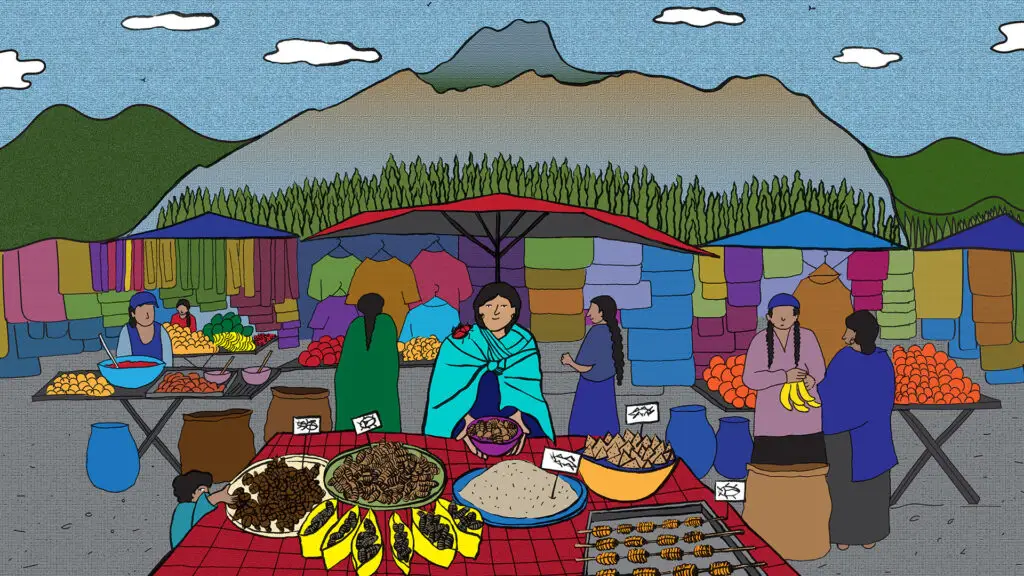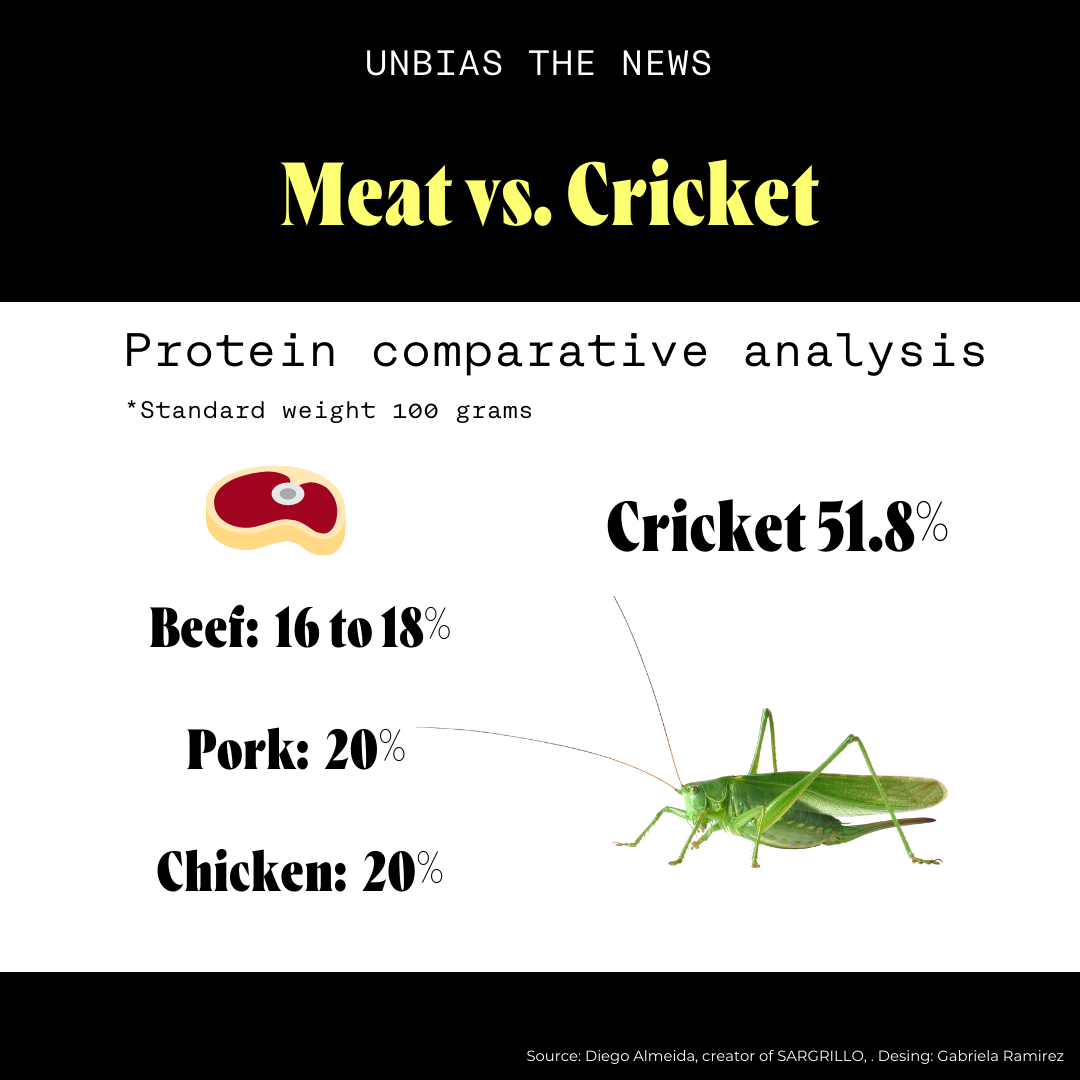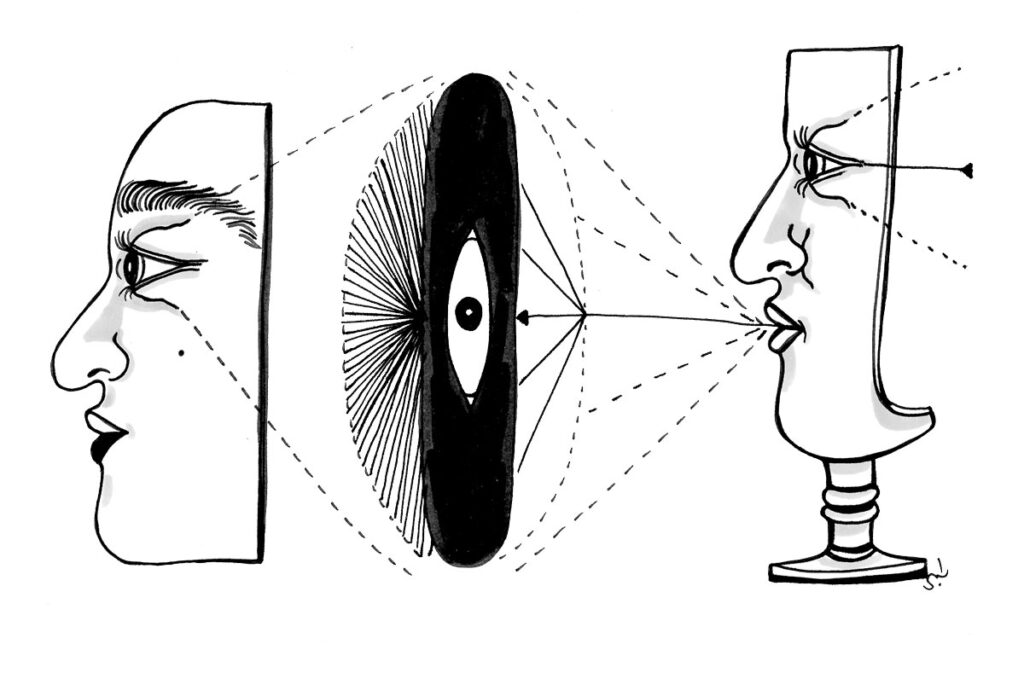Future food? Trying to revive a lost tradition in Ecuador
- Written by Mayra Prado Torres
- Edited by Purple Romero
- Illustrated by Neha Vaddadi
A history of conquest made indigenous food traditions involving insects invisible. Can the trend be reversed?
Currently, some 2,000 species of insects are consumed worldwide. According to the Food and Agriculture Organization, people consume: 31% beetles or coleoptera, 18% caterpillars or lepidoptera, 14% bees, wasps and ants (Hymenoptera), and 13% grasshoppers, locusts and crickets (Orthoptera).
In Ecuador, this consumption is ancestral, collected from the wild in the Amazon: chontacuro (chonta worm, larvae of the red palm weevil or Rhynchophorus palmarum), lemon ant (Myrmelachista) and culonas ants (Atta cephalotes). In the Sierra Norte: white beetles or catzos (Platycoelia lutescens) and brown catzos (Golofa unicolor).
However, raising and marketing crickets as a food product has not been easy due to preconceived negative notions about insects, says Diego Almeida Reinoso, a biologist and herpetologist. Invertebrate consumption is part of the country’s food culture, not only for seafood products such as clams, shells, shrimp or octopus, but also for the various insects that feed the ancestral populations, which are currently grouped into 14 nationalities and 18 indigenous peoples.
But in the city “the mental barrier induced by the idea that insects are ugly, frightening or repugnant produces an almost natural rejection,” insists Diego. This can be attributed to the conquest of native peoples and modernity, which made insect consumption invisible. Although the human groups that have inhabited Ecuador transmitted this practice generationally, in each region and from the current experience, children are the main recipients of the proposal to eat crickets.

A new generation
It took Diego seven years of trial-and-error before he discovered how to manage and optimize the breeding of crickets for human consumption. Until 2013, he used them to feed endangered frogs, but his interest in researching the nutritional properties of these insects pushed him to produce and commercialize them on a massive scale.
After having the ‘parental feet’ (parents who lay eggs for mass rearing of crickets) he refined the techniques to improve reproduction. “At the beginning, 20% or 30% of the hundred percent of eggs were hatched; reaching efficiency was a long process.”.
Finally, in his farm located in Llano Chico, a rural parish northeast of Quito, Ecuador’s capital, he stabilized the technique and achieved a nutritious product with 51.8% protein in 100 grams. In his 25-square meter laboratory, adapted with air conditioning, ventilation, shelves and containers, he developed the ‘SARGRILLO’ brand.
After the first bromatological analysis (chemical evaluation of food), he identified the enormous potential of crickets to feed other species, since insects in general are part of the diet of all animals, vertebrates and invertebrates, pollinators and biological controllers.

Taste the future
His work paid off, and now he sells several products in the local market: live or dehydrated insects, in batches from 100 to 10,000 crickets, which cost from USD 10 per batch. These include cricket snacks whose flavors range from natural, spicy and lemon flavor, pulverized cricket (pure protein to enrich other foods), multi-protein supplement. More and more people are eating crickets because they are farm-raised, he emphasizes; if they are harvested in natural areas, the environmental impacts could less severe.
SARGRILLO is sold in various areas of Quito and other cities in the country, such as Cuenca, Manta and Santo Domingo, where dishes with this protein are also prepared.
In the Eco Shop Vida Sostenible store, its owner, Carolina Saa, offers customers a ‘responsible consumption tour, ‘they visit areas such as conscious fashion, natural cosmetics, circular economy, zero waste and end in the food hanger, where they taste the cricket snack. On average, she sells 65 snacks a month, each costing a dollar
"It is a taste of the food of the future that has more protein than meat."
Carolina Saa
She also markets nutritional supplements and nachos made with cricket powder. It is all part of the circular economy, adds Diego, because it involves other entrepreneurs who make more products, such as the Crick project, which makes the nachos. In addition, the waste produced in the process is used for other purposes. The old or dead crickets are used as food for birds or pets, and the excrement is used to make fertilizer.
In Ecuador, there are typical dishes such as ceviche (coastal region), which usually have seafood, or in the Sierra the aji de cuy, whose main elements can be replaced with crickets. In Quito, restaurants such as El Ensayadero, Nuema or Viva Zapata offer dishes with this protein on the menu. In the latter, the specialty is the cricket taco. Chef Carolina Cárdenas cooks them in hot water, dresses and grills them and serves them on a tortilla with guacamole as an appetizer.
The production of cricket protein is more profitable and rational, for human or animal food, biologist and entomologist Álvaro Barragán, said. Barragán conducted a study on the usefulness of insects for development and conservation in 2016. Among his findings, he identified about 20 species of crickets and grasshoppers that can be sustainably bred for this purpose.
Giovanni Onore, former professor at the Pontificia Universidad Católica del Ecuador, made an inventory of 84 edible insects in 1997. This educational center feeds a bio web, the largest biodiversity information repository in the country, which has registered some 200,000 specimens. There are thousands more to be entered, says Fernanda Salazar, research assistant at the School of Biology.
The Balsa de los Sapos project for the conservation and research of more than 50 species of amphibians, which feed on crickets, is also being developed there. Freddy Almeida, project manager, says that many are in danger of extinction. According to Ecuador’s Red List of Amphibians, there are 635 native species and 57% are threatened.
If Ecuadorians rediscover a taste for crickets, maybe they can help reverse the extinction trend as well.








